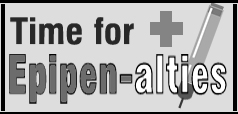Time For Epi-Penalties
JESSICA YEE
XIAOYE WANG
Copy Editor
Staff Writer
For individuals struggling with lethal allergies, epinephrine, which is usually delivered via an EpiPen, is a necessity that could mean the difference between life and death. But since Mylan, an American global pharmaceutical company, purchased the rights to its production in 2007, prices for this life-saving drug have been exploding at an exponential rate.
The price of the Epipen has skyrocketed, increasing 500% since 2008. Unfortunately, the dramatic price increase leaves low-income families behind. Epipens tend to expire after a year, which means that if families do not use their Epipen in one year, they will have to purchase another one for the following year. Furthermore, there are no viable alternatives to the Epipen. The Auvi-Q drug has been recalled, and the Adrenaclick costs $400 without insurance.
Without a viable alternative, families have resorted to filling syringes with epinephrine on their own, a complicated and risky process. To resolve this dispute, Mylan has unveiled a new “generic” EpiPen brand, priced at around $300. The generic alternative matches Adrenaclick, ensuring Mylan’s control over the drug.
Although this incident speaks to the corporate greed of drug companies, it also highlights a systemic problem in our health care industry: profits above all else. If we continue to treat drug companies as a business, we will sacrifice health for profits. According to the Wall Street Journal, the prices of 40 top branded drugs were 93% higher in the United States than in Norway. Drug companies simply cannot justify the prices of their products when other countries provide more health care.
This is not the time to be drastically increasing drug costs. Although people have taken notice to the increasing prescription drug costs, they are unable to negotiate the price of a life-saving drug. We need to take political action to ensure that people have adequate health care regardless of capricious decisions by drug companies.
MOOR graphic by CORLY HUANG
